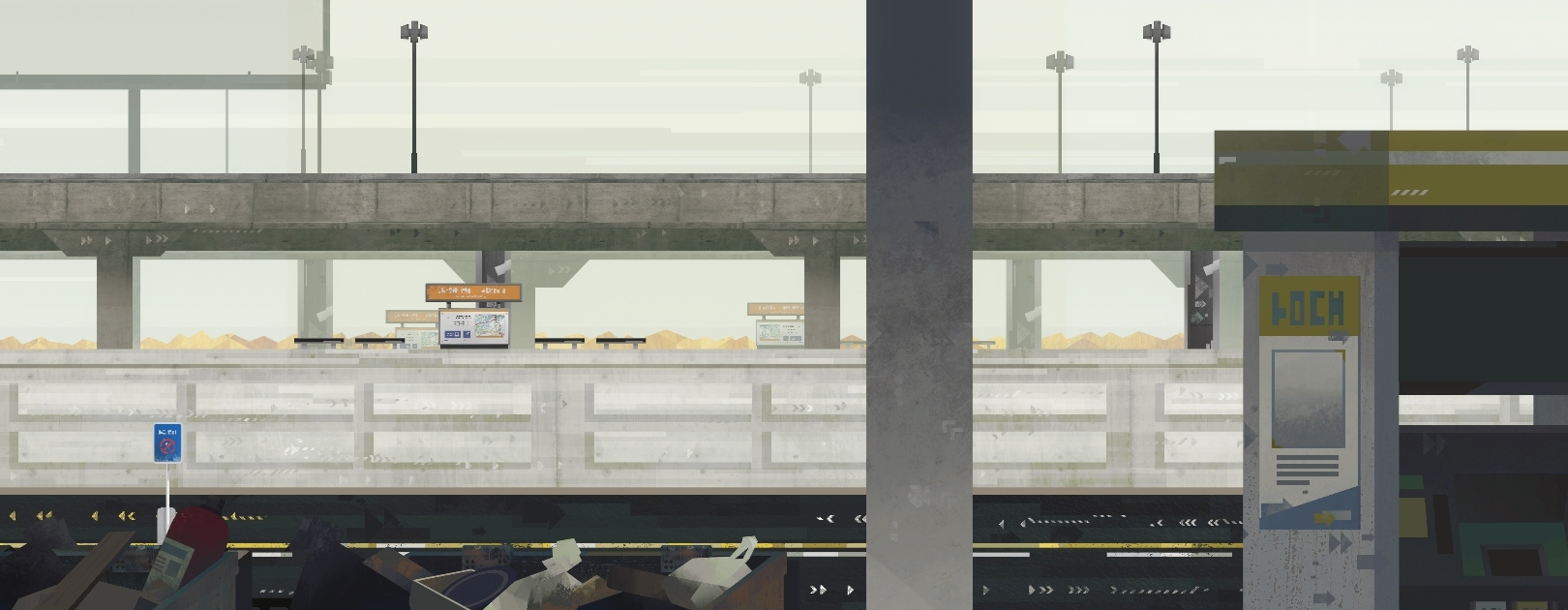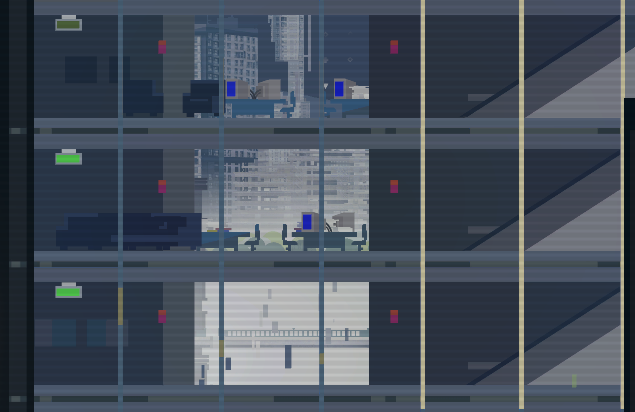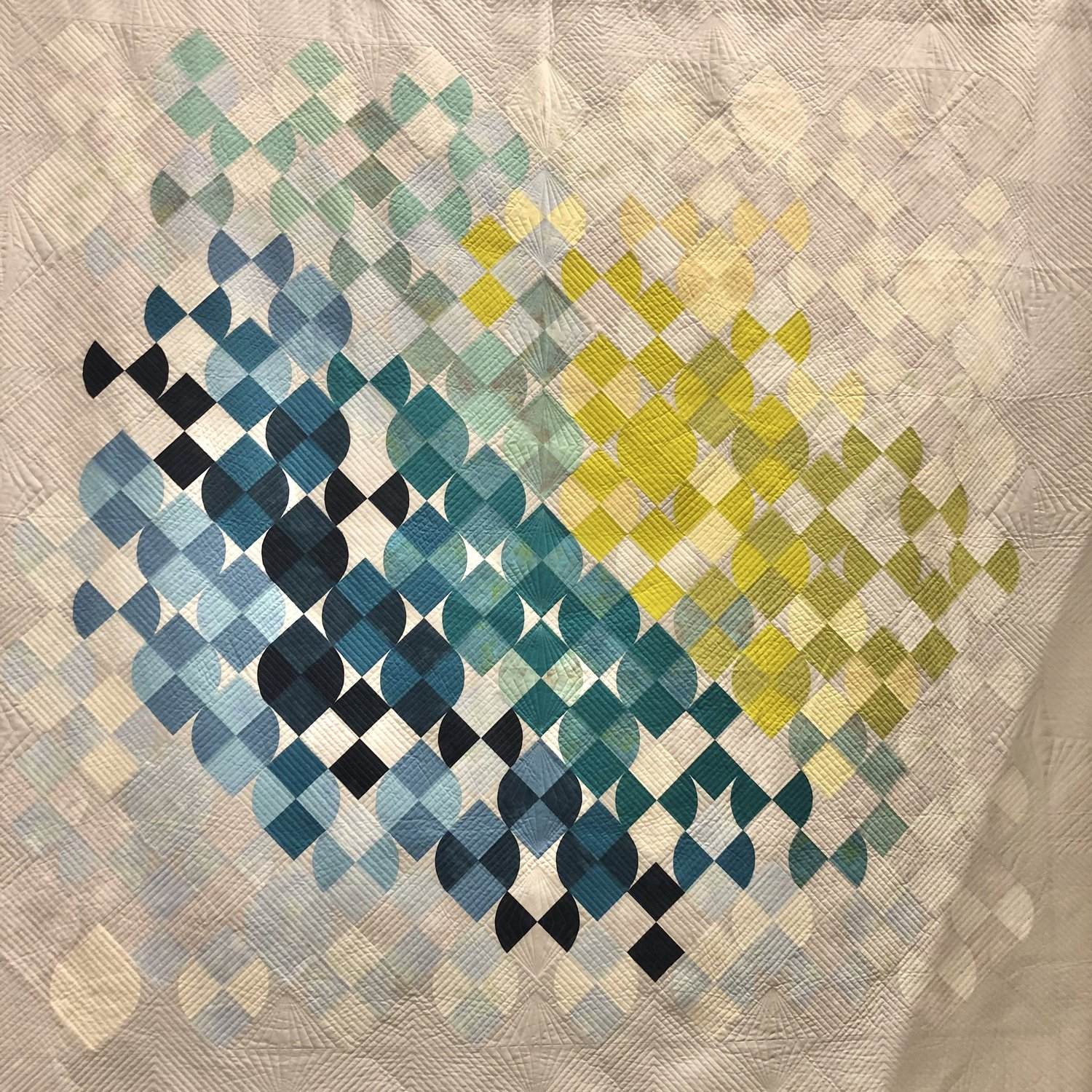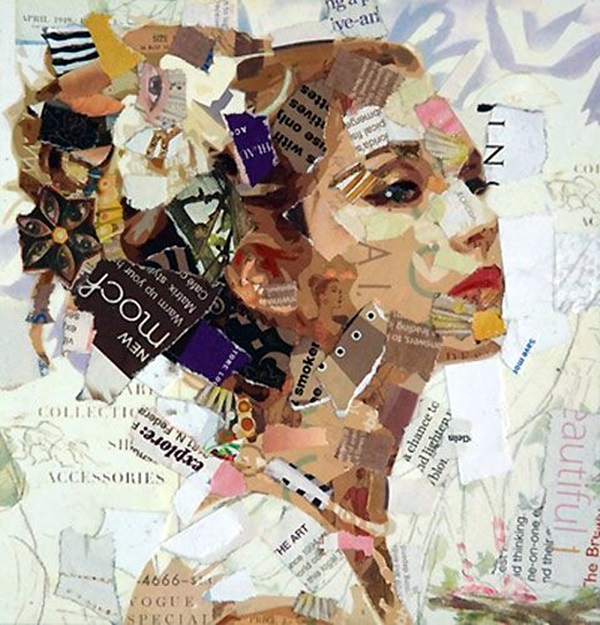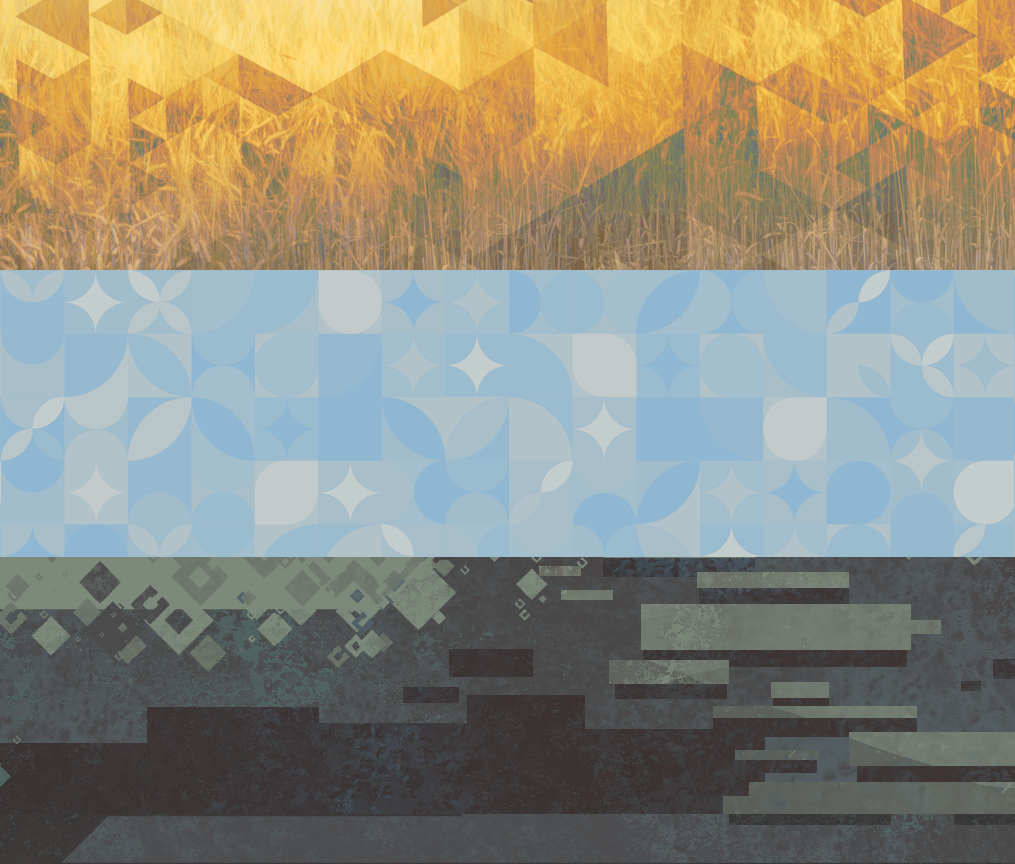There are two truths we must face when we look at nostalgia: first, that memories aren’t necessarily identical to reality; and second, most of us firmly believe that it is.
Reconciling those two comfortably wasn’t always easy but it was something I saw often in people reminiscing to each other about a shared past. They often argue about what actually happened but there was laughter despite the disagreement. That was when I began to think that nostalgia wasn’t necessarily about reality but was more about a communal consensus on how that reality felt. That often-unspoken agreement fosters fresh camaraderie because everyone believes in the same vague something in a bygone reality.
The art of CIPHER ZERO came out of a desire to evoke a sense of nostalgia and familiarity but through a lens of distorted memory, one where the player is the only person in the world but feels a sense of camaraderie with the memorabilia of a recent past.
To illustrate a world that could touch on that for an unknown diversity of people, I sought out inspirations based on a few constraints:
- The keyword was “minimalist.” The gameplay and UI are simple so the world shouldn’t be as detailed as reality.
- No matter how distorted memories are, people’s memory of the world are always rooted in some degree of reality, therefore the world must must not be so stylized that it can’t remind people of reality.
- Prioritize simple, clean shapes but do not mimic low-poly. Low-poly is currently a common aesthetic and we want an art style that can grab attention on its own.
- The places illustrated should be diverse enough to remind most players of at least one place they experienced something memorable in. Thus the art style must be able to achieve each of those locations effectively without morphing into a different style.
With those constraints in mind, I sought out sources that could accomplish my goals for the world.
James Gilleard
One of the first artists I thought of was a master of layering reality on top of geometric shapes. James Gilleard produces illustrations that feel architectural using hardline shapes, but still uses soft gradients, subtle textures, and a firm grasp on light and color that make everything feel real and organic. He has produced numerous works for the likes of Ikea, Netflix, and WIRED magazine, as well as worked on illustrations for games like Transistor (Supergiant Games) and Astroneer (System Era Softworks).
The key takeaway from Gilleard’s work is seeking out the simplest large silhouette for any object and prioritizing consistent diagonal angles (his favorite seems to be 45 degrees). I found his work to share many similarities to the art of Kurzegesagt though much closer to realism in a way that made things feel a little “better than real.”
Since this solved my simple shapes but not low-poly constraint, I made Gilleard’s approach to silhouettes one of the foundations of creating the world of CIPHER ZERO.

Left: CIPHER ZERO | Right: Concept by James Gilleard
Both use straight-on rectangular faces for the majority of the work, straight diagonals to create interest, and triangles as simplified foliage.
Theo Prins
Well known for his environmental concept art, Theo Prins uses subtle vibrance and a grand sense of scale to make his works shine. Even without human figures, his works always feel huge and the spaces expansive – I can always “smell” the places he concepts, especially his work for Guild Wars 2 (ArenaNet).
I love how vague the shapes are in his pieces but how despite that, how well-defined every material seemed to be. There was rarely any question for me of “what is that patch of something” right there despite that it all just blocks and smudges. While this didn’t additionally address any of my constraints, Prins’ work was the organic, atmospheric counterpart to Gilleard’s that I needed to design the colors of CIPHER ZERO’s spaces. Prins’ work reminds me that I should always be able to imagine myself being in CIPHER ZERO’s spaces.
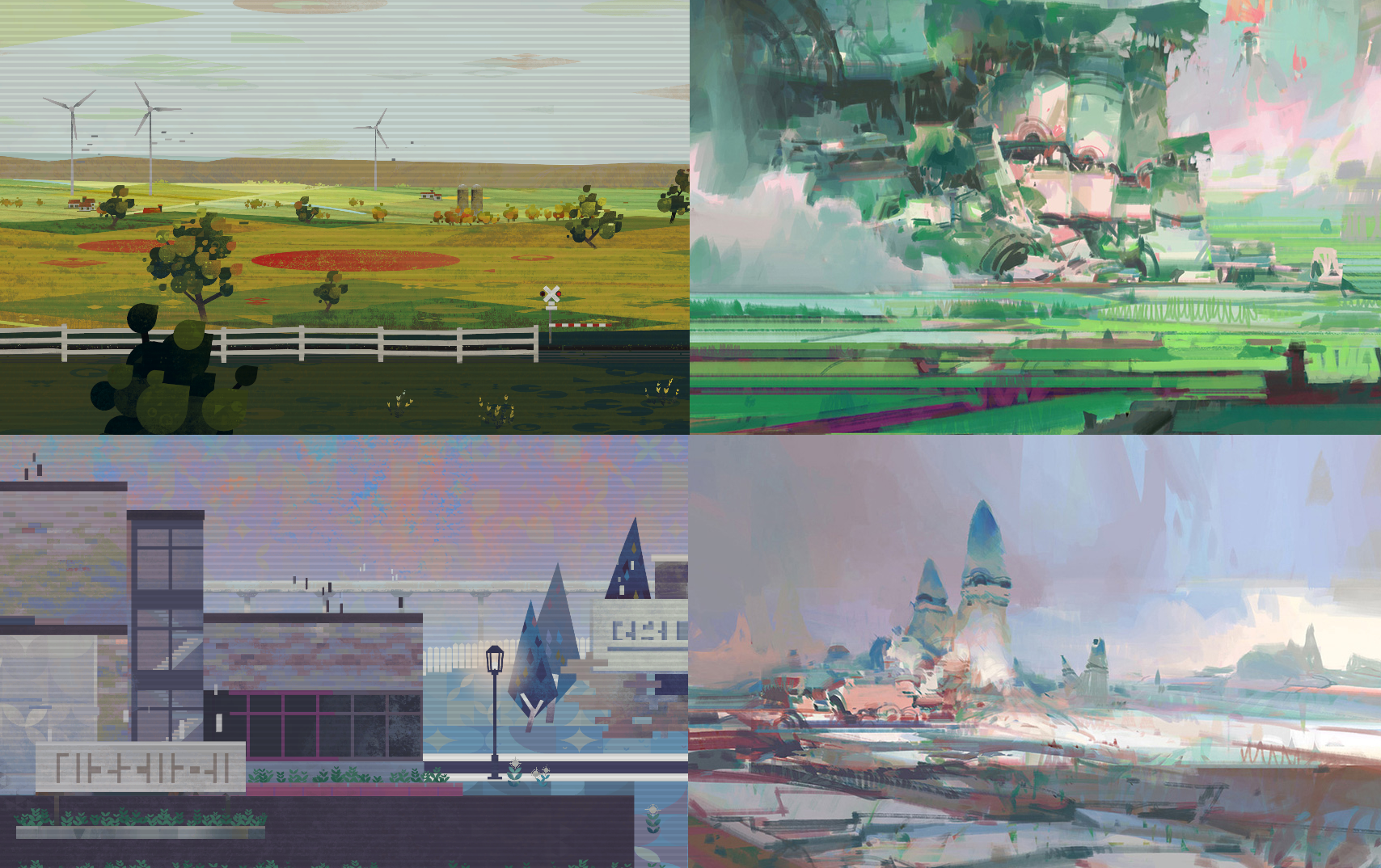
Left: CIPHER ZERO | Right: Concepts by Theo Prins
I took a lot of cues from the color choices and relationships in his works.
MS Paint
Pixel art satisfied several of my constraints. It’s minimalist – if done minimally. It can be realistic – if done realistically. It can comprise of simple shapes without appearing low-poly. It makes style consistency a breeze since it has so many of its own limitations. However much pixel art can feel nostalgic and retro, and despite that I already wanted CRT scanlines somewhere in our game, I didn’t want to approach CIPHER ZERO like it was a late 1990s adventure you could get on CD-ROM.
I remember sitting in the computer lab after school, and to the sound of my schoolmates playing Minecraft in the background, I attempted to draw a spire by faking a gradient using lines and lines of beziers in MS Paint. It was my first serious experiment foraying into digital art in an era where Google wasn’t even a popular search engine yet and when resources for learning were as scarce as programs (before everything was called an app, we called them programs) to do digital art on. There was no one and nothing to teach me how to do this, but because of that, there was no one who could tell me how I couldn’t or shouldn’t solve my problems.
I decided to approach pixel art as a feeling – not the feeling of displaying it on a professional level but the feeling of crawling into MS Paint before it had anti-aliasing built in, of dragging out a few rectangles and circles to bucket fill, and the satisfaction of scraping out out line after perfect line of squares all lined up. Because of how limited the functions are, the user had little choice but to take time and consider the best way to use the few and limited tools. Following that same method, most of the silhouettes and patterns in Cipher could be made in MS Paint, which I felt satisfied the constraint for minimalism.
Quilting and Paper Collage
I don’t know if you’ve noticed but humans really like to tile things. There’s something really satisfying about sticking similar objects next to each other and leaving no seams. Taking inspiration from that, I looked into quilting. There are a number of different types of quilting patterns. The standard square is the most popularly known one but there are also quilts made from strips of long rectangles, pie slices, hexagon, eight point stars, and six point stars, among others. There are even quilts that can look like pixel or vector art.
Paper collage is similar to quilting because it involves taking preexisting materials with preexisting patterns and piecing them together to create images. Most paper collage examples I’ve seen were very organic where the artist chooses to tear pieces of paper into irregular pieces and paste them together into larger masses. That wasn’t in line with my goals so I combined the photographic sources of paper collage and the geometric constraints of quilting for Cipher’s environment art. I sourced many textures for CIPHER ZERO from stock photos and post-processed them until they fit the coloring style I wanted.
Cipher then combines the neat tessellation of quilting and the textures of collage to give the environmental components texture. Incorporating photographs into simple geometric silhouettes satisfies the constraint to balance realism with abstraction.
The places we’ve been; the times we’ve lived through
I’ve talked to many people who want to go into art but I find that people who spend their lives grinding out piece after piece don’t necessarily have better technical skills. In order to draw well, you have to stop drawing and study reality often. In order to have something to draw, you have to stop drawing and experience something worth putting in an illustration.
The secret sauce of any nostalgia is ultimately rooted in our shared experiences: the places we’ve been, the things we’ve done there, the times we lived in — contrasting with the rise and fall of beliefs, art, design, and technology. The world of CIPHER ZERO is one where only the shadows of other people remain. I want you to believe those shadows were left behind by people who lived there, in that way; maybe even in the same time and place as you, doing the same things.
And then there is “fernweh,” a German term for longing and missing places you’ve never been. I think in some ways, fernweh and nostalgia aren’t much different, because even if the places don’t look the same, the shadows left by people who lived in a way you imagined, and who had aspirations much like yours as they looked on their familiar scenery, they share just as much nostalgia with you in a very different way.
The only way to draw that which makes someone else experience fernweh is to live convincing experiences and pour all that you remember – every smell and every texture, as imperfect or fuzzy your memory might be – into your canvas, until even a stranger can imagine the smell and touch of the same things exactly the way you remember. Then even two people who lived in different places and in different times can come to a consensus on a feeling and find camaraderie with each other.
As you play through CIPHER ZERO, please take a moment to sit in the world and experience a moment of nothing but being there. If you feel up to it, tell us a story about some place that it reminded you of or maybe a story that never happened to you. We can’t wait to hear about it!

